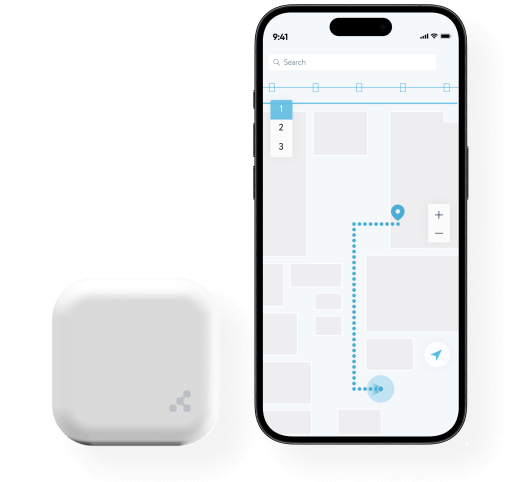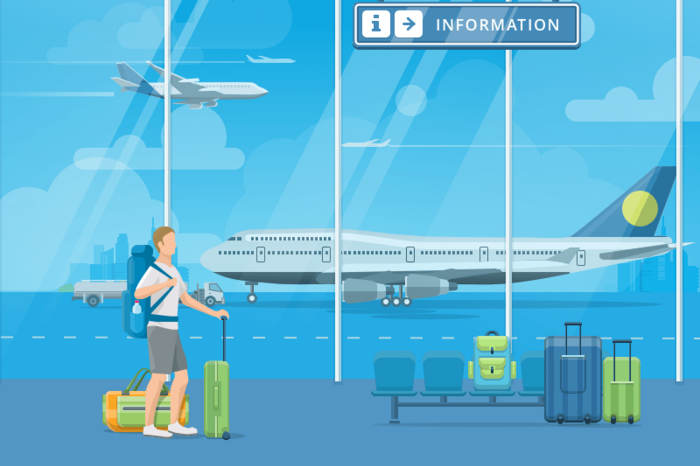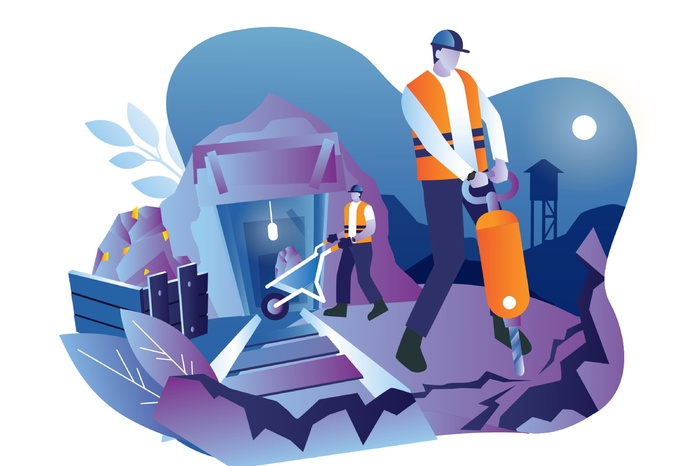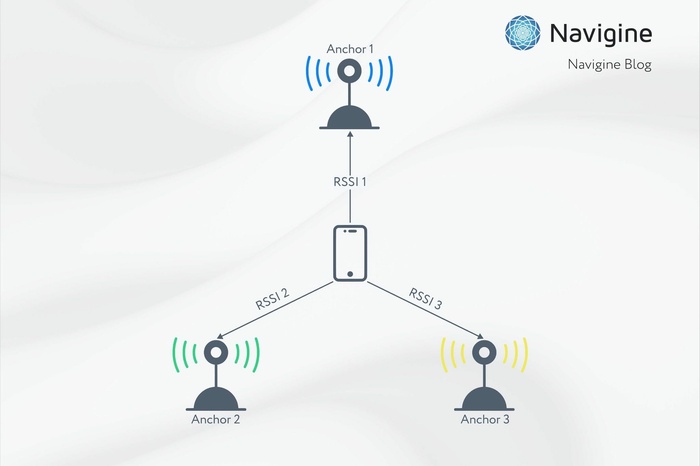Source - Mark Bijl
A Bluetooth® beacon is a tiny wireless device based on Bluetooth® technology. While installed inside buildings, it transmits a permanent radio signal that can be received by smartphones (iOS/Android), points of access, or gateways. Bluetooth® beacons are installed in stores, museums, industrial enterprises, and other rooms for collecting data on movement, delivering information, and relevant advertisements to users. They differ in low energy consumption and can transmit data to a distance of 40-60 m.
For the first time, radio beacons were presented by Apple at the Worldwide Developers Conference (WWDC) in 2013. One year later about 50 out of a hundred biggest retail chains in the USA started using them in their stores and in the following years, Bluetooth® beacons became popular in other countries of the world. At present they are considered a communicative bridge connecting the physical and digital world.
Constructive peculiarities of the Bluetooth® LE beacon
The autonomous Bluetooth® beacon consists of a plastic case with the following components inside:
- Tiny ARM computer.
- Bluetooth Smart communication module.
- Power battery.
The ARM central processor is equipped with a small antenna that ensures the transmission of electromagnetic waves of a certain frequency and length.
HOW DO BEACONS WORK?
The working principles of beacons are based on transmitting radio signals that can be received by a special Bluetooth® Low Energy gateway. After installing, the Bluetooth® beacon starts sending signals with the specified interval. When the mobile device with the pre-installed app or turned-on Bluetooth®/Wi-Fi gets into the range of the beacon, it recognizes these signals and starts performing certain tasks (sending push notifications or contextual advertisements to users).
HOW TO USE BEACONS?
Indoor navigation
Using beacons navigation helps companies to improve the quality of the services rendered to clients. Visitors are provided with indoor navigation with the possibility of building interactive maps in real-time. Using the mobile application, the person can create routes to the points of interest and quickly find the necessary places inside the building with high Bluetooth beacon location accuracy. Thus, Bluetooth® Low Energy beacons in stores can make it possible to search for the required goods and, while visiting exhibitions and museums, quickly get to the exhibits of interest. Such an approach significantly improves the user experience of clients and provides companies with direct channels of communication with visitors.
Indoor Navigation and Wayfinding BLE Kit - Kontakt.io Hardware
Try all location-powered capabilities with the Navigine Indoor Navigation and Wayfinding BLE Kit - Kontakt.io Hardware
Purchase
Location tracking
Exact positioning is an actual solution for a large enterprise. Bluetooth® location beacons perform tracking function successfully and help to define quickly the location of a person or an asset. The technology can help to:
- Track the movement of people, equipment, transport.
- Detect the misuse of working time.
- Timely react to emergencies.
- Control and redirect the flows of people.
Tracking assets and employees
Bluetooth beacons play an important role in ensuring safety in the enterprise. They can be installed on the equipment or built in the employees’ wearable devices, which allows tracking their movement. Thanks to the implementation of Bluetooth proximity beacons, the usage of the positioning system becomes an effective solution in preventing emergencies and avoiding the embezzlement of company property. Moreover, the devices help to control the staff performance. They can fix the time of attending the place, lateness, the absence at working places. The technology makes it possible to build interactive maps with access zones and perform tracking unauthorized access to such places.
Attendance analytics
The Bluetooth® low energy beacon technology offers infinite opportunities for analyzing the attendance of stores, hospitals, administrative buildings, and other institutions. They help to build heat maps, develop visitor flow maps, and define the fact and frequency of the enterprise attendance. Thanks to the obtained information, marketers can better understand visitors’ behavior and personalize the offers for specific clients.
Social and marketing interaction
While using the beacons location technology, users can be provided with attractive and relevant content. Devices can easily define the location of users, allow evaluating their behavior, and further deliver the information, according to the conducted analysis, to the users’ smartphones. Clients will get targeted push-notifications that can contain the following:
- Greetings.
- Notifications on current sales and special offers.
- Useful information on goods or services.
- Advertising proposals.
The given approach increases user loyalty makes the company more attractive for clients and encourages them to come back.
Tracking flows of people for ensuring safety at the time of Covid-19
In the face of the pandemic, Bluetooth® Low Energy beacons help the company management to undertake effective measures on preventing the spread of Covid-19 among the staff and visitors. Some vital tasks can be solved using the Bluetooth beacon tracking technology, including:
- Keeping social distancing – beacons send signals on the crowding of people in rooms or the necessity to increase the distance between users, which helps to react timely to the situation.
- Tracking contacts – positioning makes it possible to detect the number of contacts of some definite person and also estimate the duration of interactions.
- Tracking vital signs – after implementing into bracelets or individual tags on clothes, they can measure the body temperature, the pulse rate, and other parameters.
Advantages and disadvantages of Bluetooth® Low Energy beacons
One of the main advantages of these devices is their affordable cost and simple mounting. The installation of the beacon doesn’t take much time. They can be mounted on stationary and moving objects. The beacon is a transmitter that is attached to the surface and can be easily adjusted for work. Due to its low cost and low energy consumption, the device can be used for solving complicated technical tasks. The Bluetooth beacon is compatible with most mobile devices (iOS)/Android), which allows users to select the most optimal gateway.
Moreover, beacons ensure many benefits for marketers. They provide specialists with a new channel of interaction with clients and guarantee the following things:
- High level of clicks. As the statistics show, the CTR indicators of the marketing campaigns with beacons are much higher than in other advertising types. Thus, while using beacons, the click-through rate is 80% more than the similar rate in media ads.
- Possibilities for Internet retargeting. Thanks to beacon navigation systems, it is possible to communicate with clients even when they have left stores. If buyers were looking through the advertisements inside the store, marketers can later retarget them via Google Ads or Facebook.
- Returns on investment. Beacons are considered an economical way of interacting with customers, which allows reducing the costs of implementing the marketing strategy. According to the research, while using beacons, retailers can increase their profit on average by 9%, having the return on investment at about 175%. For small businesses, the ROI can reach 365%.
- Detailed analytics. The beacon-based positioning systems can monitor the behavior of visitors and get a detailed analysis of their actions for further optimization of the company’s operations. The technology allows understanding customers’ preferences, evaluating their buying habits, and creating personalized advertising campaigns for increasing profits.
Alongside the advantages, Bluetooth® beacons have some minuses. For example, they can’t work independently. The device is a part of the general system and its functioning depends on the compatible equipment. Its performance can be restricted by the quality of the Internet connection. If it’s unstable or poor, the smartphone can’t effectively receive radio signals from the beacons and execute the set actions.
BLE beacons and tags: What’s the difference?
The words ‘tags’ and ‘beacons’ are often confused or used as interchangeable notions, but these two devices differ. The main difference is in mobility. A Bluetooth® beacon for tracking is a stationary device, whereas a tag is used while moving objects. Both sensors have found their application in indoor positioning and navigation systems based on Bluetooth® LE, however, they function in a bit different ways, which has to be considered while implementing them into the infrastructure.
In most cases, beacons are mounted on walls or stationary objects. After the installation, they can be used for navigation, notifying approaching objects, and monitoring assets. Let’s consider how the sensor works based on the example of indoor navigation. The whole process is carried out in the following way:
- While working, the BLE beacon periodically sends out signals which are detected by a user’s mobile device.
- As soon as the smartphone appears within the range of the beacon, it detects the signals from the beacon and directs them to the pre-installed mobile application.
- The application receives the information and defines which action is programmed in the signal.
- In the end, the mobile application executes the predefined action.
In contrast to beacons, tags are used for wearing by people or they are attached to assets for tracking them. The main difficulty is that, during the movement, the receiver has to be motionless. Thus, in the case of Bluetooth® beacon tracking, only the mobile application and a reader are used, while for tags an additional device is required.
As a rule, a point of access or a gateway that directs information to the local server or the cloud can be an assistant in the given issue. The system gets this data and transforms it into more accessible things, such as the maps of buildings with the indication of objects’ locations in real-time.
Therefore, sensors are selected according to the way of their use. Each of them requires its own equipment, which defines the general costs of the technology implementation into the company’s infrastructure.
Application of beacons
Bluetooth® LE beacons can be applied in many spheres of our life. With the development of digital technologies, Bluetooth® beacons with low energy consumption have become widely used in the following areas:
- Retailing and shopping centers: used for navigating in stores and getting additional marketing channels.
- Airports and railway stations: help passengers to orient better inside transport hubs.
- Healthcare: let quickly find the necessary rooms, monitor the location of medical equipment.
- Logistics and warehousing: ensure close monitoring and optimization of inventory.
- Offices and property: improve positioning in large business centers and allow tracking the movement of the office staff.
- Museum and exhibitions: help create mobile guides, quickly find the exhibits of interest.
- Industry: open possibilities for constant staff and production asset tracking.
- Sport: improve navigation at stadiums and in sports centers, allow monitoring sportsmen during games.
Navigine specializes in developing and realizing indoor navigation and positioning systems. In our work, we use BLE beacons from different technological partners offering users effective geolocation solutions for business process optimization.
Are you interested in Bluetooth® beacons and indoor positioning systems? Discuss more in a private free consultation:



